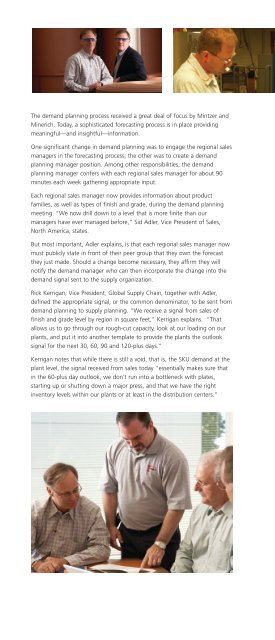Formica Case Study S&OP - Oliver Wight Americas
Formica Case Study S&OP - Oliver Wight Americas
Formica Case Study S&OP - Oliver Wight Americas
You also want an ePaper? Increase the reach of your titles
YUMPU automatically turns print PDFs into web optimized ePapers that Google loves.
The demand planning process received a great deal of focus by Mintzer and<br />
Minerich. Today, a sophisticated forecasting process is in place providing<br />
meaningful—and insightful—information.<br />
One significant change in demand planning was to engage the regional sales<br />
managers in the forecasting process; the other was to create a demand<br />
planning manager position. Among other responsibilities, the demand<br />
planning manager confers with each regional sales manager for about 90<br />
minutes each week gathering appropriate input.<br />
Each regional sales manager now provides information about product<br />
families, as well as types of finish and grade, during the demand planning<br />
meeting. “We now drill down to a level that is more finite than our<br />
managers have ever managed before,” Sid Adler, Vice President of Sales,<br />
North America, states.<br />
But most important, Adler explains, is that each regional sales manager now<br />
must publicly state in front of their peer group that they own the forecast<br />
they just made. Should a change become necessary, they affirm they will<br />
notify the demand manager who can then incorporate the change into the<br />
demand signal sent to the supply organization.<br />
Rick Kerrigan, Vice President, Global Supply Chain, together with Adler,<br />
defined the appropriate signal, or the common denominator, to be sent from<br />
demand planning to supply planning. “We receive a signal from sales of<br />
finish and grade level by region in square feet,” Kerrigan explains. “That<br />
allows us to go through our rough-cut capacity, look at our loading on our<br />
plants, and put it into another template to provide the plants the outlook<br />
signal for the next 30, 60, 90 and 120-plus days.”<br />
Kerrigan notes that while there is still a void, that is, the SKU demand at the<br />
plant level, the signal received from sales today “essentially makes sure that<br />
in the 60-plus day outlook, we don’t run into a bottleneck with plates,<br />
starting up or shutting down a major press, and that we have the right<br />
inventory levels within our plants or at least in the distribution centers.”

















